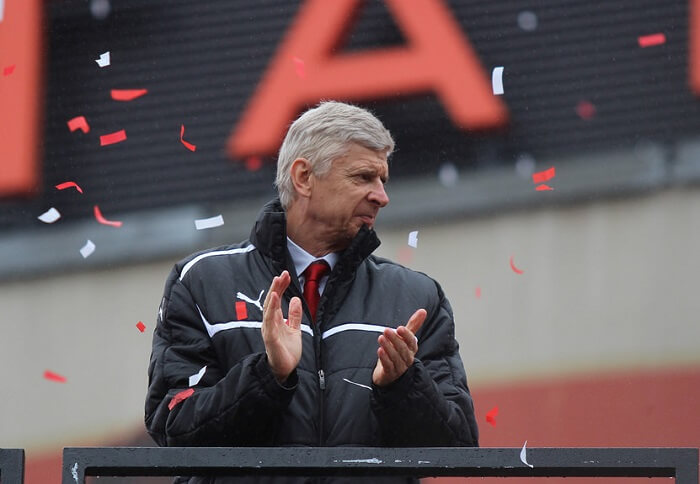The arrival of Pep Guardiola as Manchester City’s new manager has triggered much excitement about the Premier League as the glorious euphoria of Leicester City’s underdog triumph has gradually begun to fade.
Manchester United landing Jose Mourinho has also fuelled this anticipation thanks to his long, twisted history with Barcelona and Guardiola. Cries of “Wenger Out” have subsided for the time being after Le Professeur ensured an unparalleled 19th successive season of Champions League football.
The signing of Swiss midfielder Granit Xhaka following a solid season of tackling and passing at Monchengladbach, and the speculation around last season’s record-breaking rags-to-riches goal-scoring hero Jamie Vardy, has prompted Gunners around the world to have their ears on the ground for more news of transfers.
Signing marquee players was never Wenger’s cup of tea but in a league of obscene riches and competitive mid-table clubs, the frustration of certain sections of fans at the over-reliance on raw, talented but unproven youth players is understandable.
To win a league requires more than putting expensively assembled players together. Mourinho, Roberto Mancini, and Louis van Gaal can all vouch for that. So, does Wenger need to rethink this style in the context of how much football has changed since he last saw unseen heights of success with the Invincibles?
This is where looking at the undeniable success of Guardiola and Mourinho might give us a clue. Over his seven years as manager at two established super clubs, Barcelona and Bayern Munich, few teams have been able to hold their own against Pep’s combination of high-quality players and possession-hungry style.
Six league titles, four domestic cups and two Champions League trophies in seven seasons is, after all, no small feat. The Invincibles were an inspiring team that took an established 4-4-2 system and tweaked it to incredible efficiency.
Thierry Henry and Dennis Bergkamp formed a strike partnership that revolutionized chance-creation due to their shared individual intelligence and complementary qualities with the Dutchman playing just behind the Frenchman.
Every single member of that team deserves all the praise that goes in their direction, especially the midfielders Patrick Vieira and Gilberto Silva who provided and excellent base for the attacking players to flourish.
However, it was the build-up play made possible because of the two strikers, who split towards the wings without the ball to provide outlets for the ball-winners in midfield and converged one behind the other once possession was regained that really send Arsenal to the top of the league.
Jose Mourinho arrived in England in 2004 and shook up the league with his lopsided stress on the defensive base. What Vieira and Roy Keane did before, Claude Makelele did better because he was relieved of the attacking duties of midfielders from the previous era. Chelsea sat deep, Makelele broke up play, and spread the ball towards the wings and Chelsea counter-attacked with efficient precision.
Mourinho, at the first signs of team failure, instructs his team to leave the ball alone and focus on choking the space around opposition players and had no qualms about spending on exactly the kind of players he needed.
Wenger’s style of play assumes that all teams participate, or at least should participate, in a match with the same ethos: the team that keeps the ball is the better team and the better team has a duty to always try to score. The legacy of Johan Cruyff’s work at Ajax, Barcelona and the Netherlands national team is hard to miss in this ethos.
It was Guardiola’s Barcelona, with his training in Cruyff’s ethos from his long career there as a player, which stood up to the irreverence of Mourinho. Barcelona held the ball more than any other team and passed the ball better than any other team with a midfield of Andres Iniesta, Xavi Hernandez and Sergio Busquets feeding a Lionel Messi keen to make prophecies true and records history.
This forced even the managers of the biggest clubs with the best players to adopt the Mourinho style as the only way to counter Barcelona. Atletico Madrid have improved upon this Mourinho model, with Diego Simeone ushering in a return of the two-striker formation with Antoine Griezmann and Fernando Torres up top. Claudio Ranieri used it to surprisingly good effect with Leicester.
Guardiola has now arrived in England, the haven of counterattacking football, to restore the Cruyff ethos to the Premier League. He shares a preference for similar kind of players in similar kind of roles with Wenger and both of them have only recently started ceding the need to buy proven top players from top clubs.
Both of them believe playing a particular kind of football that the fans and club can identify with is more important than winning individual matches. So, should Wenger rethink his style in this league gripped by counterattacking mania? Not just yet but he can take a leaf out of Guardiola’s book and not shy away from getting the exact kind of player, no matter how expensive, he needs for his system to work.




